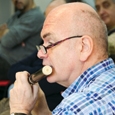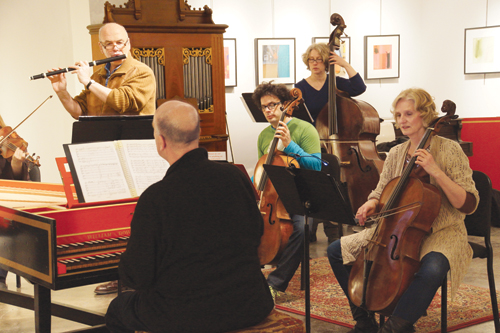
Internationally acclaimed Dutch flutist, Wilbert Hazelzet has performed and recorded with Europe’s most prestigious Baroque ensembles including Musica Antique Köln, the Amsterdam Baroque Orchestra, Musica Antiqua Amsterdam, and the Orchestra of the 18th Century. He frequently collaborates on Baroque chamber music projects with harpsichordist Jacques Ogg and gambist Jaap ter Linden.
Hazelzet’s many years of teaching at the Royal Conservatory of the Hague, the Akademie für Alte Musik Bremen, and the Utrecht and Tilburg Hogescholen voor de Kunsten have inspired generations of Baroque flutists. His passion for Baroque music combined with his positive guidance in the development of young musicians has made an indelible impact on the field of Early Music.
How did you become interested in playing the traverso?
I come from a family with a strong connection to music. Since my parents grew up in a time without radio, television or computers, they created their own entertainment through music lessons, choirs, amateur opera associations and chamber music ensembles. During the winter seasons, their concert and theatre abonnements provided them with inspiration.
As a child, I was given piano and flute lessons, and later studied flute with Adriaan Bonsel at the Utrecht Conservatory. There, one of the people who had a great impact on students’ musical life was Hans Brandts Buijs. As the conservatory choral conductor, he was passionate about Bach’s music and founded the Utrecht Studenten Koor & Orkest’s Bach tradition. From the 1940s to 1960s, Buijs painstakingly wrote out individual orchestral parts from the scores of many Bach cantatas. Buijs’s successor, Jaap Dillen, invited me to participate in performances of the great Bach works. Later Syntagma Musicum’s flautist and keyboard player, Barbara Miedema, sent me to one of Bart Kuijken’s first summer courses. Soon after, Ton Koopman and Jacques Ogg heard me and invited me to collaborate with them.
Having been recommended by Ton Koopman, I became a member of one of the first Musica Antiqua Köln ensembles in 1977. In fact, it was not yet an orchestra at all. Reinhardt Goebel’s idea was to create an Early Music Ensemble that worked together as intensely as a romantic string quartet, but with a mainly trio instrumentation (two violins and basso continuo) plus additional winds. This was only possible through long rehearsals, repeating our pieces until they seemed to sit well and became fully established in our reflexes. We started rehearsing at 10 am, with a lunch break from 1-2 pm, continued rehearsals from 3-7 pm, and finished with an hour of repertoire sightreading until 8 pm. This thorough training was obviously not always easy nor without stress.
This type of methodical preparation marks you profoundly. It is not only musical, but shapes your personality also. By chance, Musica Antiqua Köln was a group of people who wanted to work in this intense way. Even so, one should not start believing that the whole world is into this. That would be a mistake, and might lead to wrong expectations of people for whom this approach simply does not work.
What is your teaching philosophy?
I believe in supporting students and not just leaving them too much alone at a masterclass for example. I think that it is important for a student not to feel in opposition to a teacher or the public. This can really have a big effect on a young student who is taking a risk playing in public classes. I remember that from my own experiences. We should not forget this when we stand on the other side of the line as the teacher.
Here, the philosophy of the next step comes in. There are so many reasons that somebody’s performance might be less satisfactory. It may be the consequence of something the night before, the day before, the year before, or the decade before. A teacher cannot always possibly know, but whatever the moment offers, there is always something to learn. One can discover the next step and move from less to a little bit more. The goal of a masterclass is not necessarily to prove that one is up to playing at Carnegie Hall. If a teacher can simply help a student discover the next step, then the public or individual lesson has had its function.
Contact with students is a wonderful exchange and a gift of life. You cannot see that when you start teaching, but it is revealed over the years. I am grateful to continue to teach today. In European conservatories, the mandatory retirement age is 65, but I have been asked to still help out a little in the Utrecht and The Hague conservatories, in addition to ongoing summer courses at the Baroque Academy at Amherst, Baroque Instrumental Programme in the Twin Cities, and the Berwick Academy. Teaching helps to stay alive creatively and spiritually.
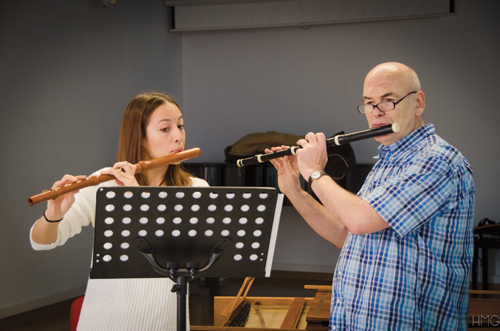
What are some common mistakes that you see in teaching?
Teaching styles seem to have evolved over the last 50 years. Up until the 1950s and 60s at European conservatories, it was quite common to put pressure on students by being negatively critical, hoping that students would psychologically and musically fight against their teachers and improve. I really find this difficult to believe in. Supposing that a musical person is a sensitive person, I think that just like an oyster, you close up in a suppressive atmosphere. This is counterproductive to creativity, musical production, art, and expression.
Try to understand the students’ goals and perspectives on learning. Teachers are often tempted to use masterclasses to display their skills and virtuosity. That is not so useful to students. We might believe that the public is amused or impressed by it. However, if students are standing there ready to play a piece, hoping for some help from the teacher, and instead have to stand there listening to a conference and a beautiful speech, they easily lose all the fun and the attitude of playing. Then the masterclass is just a disaster.
Why do you sing the bass line while teaching?
Understanding harmonic context is indispensable. To help with this, one can play, arrange and transform any bass line in the flute part, which gives students a musical surrounding to better understand the piece. As a usable harpsichord is not always available, and playing a stringed bass instrument does not belong to my capabilities, I simply use my bass voice. Singing the bass line has two advantages. First, it is rather convenient and often more efficient to indicate musical inflections in the piece in a suggestive way. Second, while singing, one can even express a little comment or stimulating hint by adding a text to the notes. We may also hope that by mere identification and imitation, the musical intuition of the student is triggered.
Why do you focus so much on teaching variety and precision in articulation?
If a composition is like a speech, and playing should be like singing, and singing like declaiming, then good articulation and diction become essential to conveying a musical message. For example, in his method, L’Art de Bien Chanter, Bénigne de Bacilly writes more about declamation, articulation, and diction than about voice placement or development. If performing is like declaiming, in many cases it is certainly like declaiming in a foreign language. This means that we should pay attention and mind the details, just as we do when listening to a text, spoken or sung. For example, in speech we have to distinguish clearly between plural and singular nouns. We should strive to do the same when learning a piece of music. We should try to understand the shape of the musical elements and their meaning and pronunciation. Try to define and analyze smaller and larger structures, the phrases and their grammar and syntax, as well as the emotional value or affect in order to put everything together again and try to create a complete story of music. Then we could be ready to present it to others.
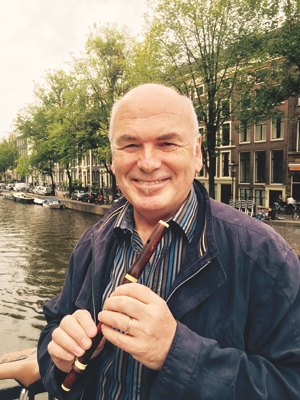 How is the voice related to teaching and playing the flute?
How is the voice related to teaching and playing the flute?
When you are not afraid of your voice and feel free to make a noise, you can make music with a clear presence, and you can play the flute. If it is still difficult to open that door, daring to make the voice resonate, then the process of making music may have a slower, more difficult start. Sometimes students come into a lesson, whispering as if they need to apologize for their presence. In this case there is a lot of work to do. In general, when someone comes in with a resonating presence, I feel a lovely relief because the ways to expression are free.
Technically, voice awareness allows a conscious relaxation of the whole throat area, which is of course crucial for flutists. When there is less restriction or tension in the throat, sound production most likely is easier and more satisfactory. So many of the techniques that modern singers use to free up the larynx and mobilize all the resonances in the body are also quite useful in flute playing.
What advice do you have for young musicians?
Reserve time for dreaming and imagining. Maybe spend a few hours really identifying with Bach and his life in Köthen, trying to imagine the atmosphere of the building, the composer’s way of living, the sculptural and pictorial art, literature and social structures of the period. This can become a different way of developing your musicianship. It is a big pity that just when all the technical skills are in place, and everything could just start, that some young people seem to stop. I understand that the reality of a young musician’s life today needs to be so practical. It is not so easy for young professional musicians these days. There is not so much time for dreaming. It is all a matter of getting the notes together, presenting yourself, and getting known. Maybe their music comes out a little bit straightforward as a result and not so extremely inspired, personalized or deep as one could imagine. However, when young musicians grow and take the opportunity to look back on their performances and their work, they should take more time to reflect on it. They might discover different ways of creativity and find the time to allow for the integration of ideas into their imagination and vision.
What are the main points about Baroque music that you teach to modern flutists?
With 18th century musical texts, there are many ways of reading the music. Musicians can learn from the information found in treatises that describe the ways of playing that are not marked in the music. They concern the imagination of unmarked, but supposed dynamics, sound shaping and articulations, and possible realizations of ornamental symbols that lead to hidden effects.
Everything basically results from a general idea of unevenness. This can be found in dynamic intensity, rhythm, and tonalities, as well as in the period instruments themselves. Unevenness in music is comparable to expressive language in conversations. This kind of understanding leads to developing and deepening the sensation of telling, or declaiming the musical texts. These historical sources often compare musical performance and public speech through the use of impulses and inflections. Many players have proved that these effects can be incorporated into performance on modern instruments.
How should flutists ornament Baroque pieces?
This is an immense answer, but the short answer is to get hold of Hans-Peter Schmitz’s most valuable book, Die Kunst der Verzierung. Play and read all of the musical examples and discover how melody transformation into ornaments can work in different styles. Then look at the bibliography for more examples from the repertoire. This is a practical way to start, allowing orientation in the field and providing a rich basis for future study.
Another recommendation is to obtain some of the inspiring and practical compilations by Betty Bang Mather and David Lasocki, including Free Ornamentation, The Classical Woodwind Cadenza, French Music, and The Art of Preluding, and proceed in the same way. It is a matter of building up your own stock of ideas. Look at learning the ornaments as the vocabulary of a foreign language.
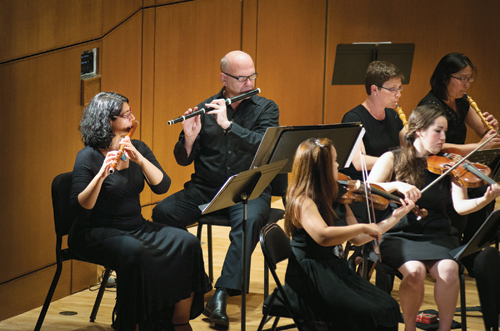
What is your favorite style of traverso music?
I have a small preference for the Empfindsamer Style because of its sudden and dramatic affect changes. Identifying with this style triggers a type of musical intuition; it allows us to express and to reach expression. Of course, you have to figure out, how to do it – which constellation of notes to link with which expression, and how to follow the roads, seeing the switches. When you plan to perform this type of music on stage, you need to allow yourself to experience the feelings, at least while practicing. Take to heart Quantz’s words, that real emotion can only be conveyed when the musician is touched by the emotion of the music. We are meant to simultaneously be actors and musicians.
What are your thoughts on the importance of research for a performing musician?
Research allows the development of historical awareness, situating the chosen works, and defining their function in life and cultural environment. For flutists, these factors may influence the choice of sound, timbre, volume, dimensions of presence, the choice of types of flutes (if there even is a possibility to specify), and diversifying the use of accompanying basso continuo instruments. Research brings us into deeper contact with the impact and meaning of a composition, provides a richer variety of views and possibilities concerning the execution of the music, and so, enriches our imagination.
The discovery process is long term and also mixed with so many less well-documented performances. We should collect documentation material over the years, while still enjoying the music itself, feeling it intuitively, and being inspired and touched by its mere presence. For example, while the Willem Mengelberg version of Bach’s St. Matthew Passion, is considered stylistically completely anachronistic nowadays, it deeply touched thousand of listeners in its time.
What qualities do you look for when purchasing a new traverso?
I look for timbre and direct speech and refined articulation. Tuning, according to the period, is the next important feature. Pitch may play a role. Personally, I prefer to pull out the flute, to fundamentally having to push its pitch up. I deeply thank the few traverso makers Alain Weemaels, Roderick Cameron, Rudolf Tutz and Remko van der Vegt for their relentless and beautiful work. The one-keyed instruments by Jean Hyancinthe Rottenburgh and Carl August Grenser always have been a great inspiration.
Although I do not own any playable original traversos, having a chance to play and hear an original instrument is often an encounter with irreplaceable timbres and resonances. These originals teach us that modern performance circumstances (especially when a large orchestra is involved) often oblige us to go far beyond the nature and the capacities of the original instruments and distort their beauty. An enlarged Mona Lisa needed in order to cover a skyscraper might indeed lose quite a bit of her charm.
I wish for future generations that people keep their sense of curiosity and find time to let their imagination to develop. People take the time to discover all of the fantastic museums waiting for us. Reserve two hours to visit inspiring collections like the gorgeous Frick collection in New York City, the impressive historical instrument museums such as the Dayton Miller Collection and National Gallery in Washington D.C., the wonderful Cleveland Museum, and the National Music Museum in Vermillion. They provide so much information about music and cultural life in former times and can provide inspiration for years of concerts.
Let us hope that the future provides Early Music with courageous organizers, who will set up situations that keep confronting the public with the intimacy, subtlety and sensitivity of early chamber music, as opposed to the very tempting tendency of going bigger and louder. It is a huge challenge to find spaces, funding, and the right publicity. The future seems to promise an enormous variety of musical experiences, showing that the creative process of interpretation will always bring kaleidoscopic results.
